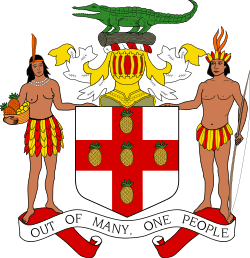Alexander Bustamante
| The Right Excellent Sir Alexander Bustamante GBE | |
|---|---|
 | |
| 1st Prime Minister of Jamaica | |
|
In office 29 April 1962 – 23 February 1967 | |
| Monarch | Elizabeth II |
| Governor-General |
Sir Kenneth Blackburne Sir Clifford Campbell |
| Succeeded by | Sir Donald Sangster |
| 1st Chief Minister of Jamaica | |
|
In office 5 May 1953 – 2 February 1955 | |
| Monarch | Elizabeth II |
| Governor | Sir Hugh Foot |
| Succeeded by | Norman Manley |
| Personal details | |
| Born |
William Alexander Clarke 24 February 1884 Hanover, Jamaica |
| Died |
6 August 1977 (aged 93) Irish Town, Jamaica |
| Nationality | Jamaican |
| Political party | Jamaica Labour Party |
| Spouse(s) | Gladys Longbridge (1962–1977; his death) |
| Religion | Roman Catholic |
Sir William Alexander Clarke Bustamante GBE PC (24 February 1884 – 6 August 1977) was a Jamaican politician and labour leader who became the first prime minister of Jamaica. Bustamante is honoured in Jamaica with the title National Hero of Jamaica in recognition of his achievements.
Early life and education
He was born as Alexander Clarke to Mary (née Wilson), of mixed race, and her husband Robert Constantine Clarke, an Irish Roman Catholic planter, in Hanover, Jamaica.[1] He said that he took the surname Bustamante to honour a Spanish sea captain who befriended him in his youth.[2]
After travelling the world, including working as a policeman in Cuba and as a dietician in a New York City hospital, Bustamante returned to Jamaica in 1932.
Marriage and family
Bustamante married Gladys Longbridge on 7 September 1962.
Entry into politics
He became a leader in activism against colonial rule. He gained recognition by writing frequent letters on the issues to the Daily Gleaner newspaper. In 1937 he was elected as treasurer of the Jamaica Workers' Union (JWU), which had been founded by labour activist Allan G.S. Coombs. During the 1938 labour rebellion, he quickly became identified as the spokesman for striking workers, who were mostly of African and mixed-race descent. Coombs' JWU became the Bustamante Industrial Trade Union (BITU) after the revolt, and Bustamante became known as "The Chief".
In 1940, he was imprisoned on charges of subversive activities. The widespread anti-colonial activism finally resulted in Parliament's granting universal suffrage in 1944 to Jamaica. Released from prison in 1943, Bustamante founded the Jamaica Labour Party the same year. Previously he had belonged to the People's National Party (founded in 1938 by his cousin Norman Manley). Bustamante's party won 22 of 32 seats in the first House of Representatives elected by universal suffrage. He became the unofficial government leader, representing his party as Minister for Communications, until the position of Chief Minister was created in 1953. He held this position until the JLP was defeated in 1955. In 1947 and 1948, he was elected as mayor of Kingston. In 1952 he was arrested by the American authorities while he was on official business in Puerto Rico.[3]
Though initially a supporter of the Federation of the West Indies, during the 1950s, Bustamante gradually opposed the union. He agitated for Jamaica to become independent of Great Britain. He said that the JLP would not contest a by-election to the federal parliament. His rival and cousin, Premier Norman Manley, called a referendum on the issue in 1961; Jamaicans voted for the nation's withdrawal from the Federation.
After Jamaica was granted independence in 1962, Bustamante served as the first Prime Minister until 1967. In 1965, after suffering a stroke, he withdrew from active participation in public life, and the true power was held by his deputy, Donald Sangster.[4]
In 1969, Bustamante was proclaimed a "National Hero of Jamaica", along with Norman Manley, the black liberationist Marcus Garvey and two leaders of the 1865 Morant Bay rebellion, Paul Bogle and George William Gordon.[5][6] His portrait graces the $1 Jamaican dollar coin.
Bustamante died in 1977 and was buried in the National Heroes Park in Kingston.[7]
Bustamante backbone
A Jamaican candy, the Bustamante backbone, is named for him.[8] It is a hard, grated coconut and sugar confection "which is said to represent his firmness of character." Bustamante was considered a "buster", "a champion of the common man and tough article."[9] Gizzada is a similar sweet.
References
- ↑ "Bustamente's Rise to Prominence", Jamaica , 2 February 2006 Archived 26 September 2007 at the Wayback Machine.
- ↑ Gould, Peter (8 April 2005). "Biography". BBC News.
- ↑ Parker, Matthew (2014). Goldeneye. London: Hutchinson. p. 148–49. ISBN 978-0-09-195410-9.
- ↑ Harris M. Lentz (ed.), "Jamaica: Heads of Government", Heads of States and Governments Since 1945, Routledge, 2013, p. 450.
- ↑ "Jamaica's National Heroes: Their Legacy 50 Years Later", Jamaicans.com.
- ↑ "Heritage: Jamaica's National Heroes", Island Buzz Jamaica, 17 October 2011.
- ↑ "August 8th funeral for Lady B". Jamaica Observer. 30 July 2009. Archived from the original on 2 August 2009. Retrieved 2009-08-02.
- ↑ Rebecca Tortello "Sweet & dandy - The history of Jamaican sweets", The Gleaner (Jamaica), 7 February 2009
- ↑ Frederic Gomes Cassidy, Robert Brock Le Page. Dictionary of Jamaican English
External links
| Government offices | ||
|---|---|---|
| Preceded by None (New Position) or British Governors of Jamaica |
Chief Minister of Jamaica 1953-1955 |
Succeeded by Norman Manley |
| Preceded by Norman Manley |
Prime Minister of Jamaica 1962-1967 |
Succeeded by Sir Donald Sangster |

